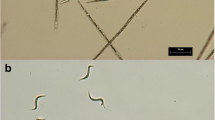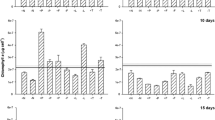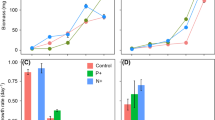Abstract
Radiocystis fernandoi Komárek and Komárková-Legnerová has great ecological importance in tropical regions, due to its widespread occurrence in freshwaters in the American continent, besides its ability to form blooms and to produce toxins. Global warming has a very important and positive role on cyanobacterial development considering that the growth rate of these organisms increases at temperatures above 25 °C. Considering that there is no information in the literature about the effects of temperature on the development of R. fernandoi, we performed an experimental study on its effects on growth and microcystin-LR production, employing a tropical microcystin-producer R. fernandoi. The selected strain was tested at three temperatures: 20, 25 and 30 °C and sampled at intervals of 2 days including different growth phases. Our results show that the strain presents greater growth rates and the smaller cell size at 25 and 30 °C. Differently from Microcystis aeruginosa (Kützing) Kützing that presents the greatest microcystin production at the end of the exponential growth phase, R. fernandoi produced microcystin only in the stationary phase. This result emphasizes the importance of monitoring Radiocystis blooms for a long period of time considering that these toxins remain in the water for up to 42 days. Thus, besides the morphological differences between M. aeruginosa and R. fernandoi, our results reveal that physiologically these cyanobacterial species also present different strategies that allow them to co-occur in nature forming long-lasting blooms.




Similar content being viewed by others
References
Azevedo MTP, Sant’Anna CL (2003) Sphaerocavum, a new genus of planktic Cyanobacteria from continental water bodies in Brazil. Algol Stud 109:79–92
Borges PAF, Train S, Rodrigues LC (2008) Estrutura do fitoplâncton, em curto período de tempo, emum braço do reservatório de Rosana (Ribeirão do Corvo, Paraná, Brasil). Acta Sci Anim Sci 30:57–65
Borges PAF, Train S, Dias JD, Bonecker CC (2010) Effects of fish farming on plankton structure in a Brazilian tropical reservoir. Hydrobiologia 649:279–291
Butterwick C, Heaney SI, Talling JF (2005) Diversity in the influence of temperature on the growth rates of freshwater algae, and its ecological relevance. Trop Freshwat Biol 50:291–300
Carey CC, Ibelings BW, Hoffmann EP, Hamilton D, Brookes JD (2012) Eco-physiological adaptations that favour freshwater cyanobacteria in a changing climate. Water Res 46:1394–1407
Carvalho LR, Pipole F, Werner VR, Laughinghouse HD IV, Camargo ACM, Rangel M, Konno K, Sant’Anna CL (2008) A toxic cyanobacterial bloom in an urban coastal lake, Rio Grande do Sul State, Southern Brazil. Braz J Microbiol 39:761–769
Davis TW, Berry DL, Boyer GL, Gobler CJ (2009) The effects of temperature and nutrients on the growth and dynamics of toxic and non-toxic strains of Microcystis during cyanobacteria blooms. Harmful Algae 8:715–725
Dziallas C, Grossart HP (2011) Increasing oxygen radicals and water temperature select for toxic Microcystis sp. PLoS ONE 6:e25569
Fastner J, Flieger I, Neumann U (1998) Optimised extraction of microcystins from field samples—a comparison of different solvents and procedures. Water Res 32:3177–3181
Ferrari G, Pérez MC, Dabezies M, Míguez D, Saizar C (2011) Planktic Cyanobacteria in the lower Uruguay River, South America. Fottea 11:225–234
Fogg GE, Thake B (1987) Algae cultures and phytoplankton ecology. The Univessity of Wisconsins Press Ltd., London
Fonseca IA, Maniglia TC, Rodrigues L, Prioli AJ, Prioli SMAP (2011) Identificação do gene mcyA em florações naturais de Radiocystis fernandoi, em um tributário do reservatório de Rosana, Brasil. Acta Sci Biol Sci 33:319–324
Grzebyk D, Berland B (1995) Influences of temperature, salinity and irradiance on growth of Prorocentrum minimum (Dinophyceae) from the Mediterrane Sea. J Plankton Res 18:1837–1849
Harris GP (1986) Phytoplankton ecology: structure, function and fluctuation. Chapman and Hall Press, London
IPCC (2014) Intergovernmental panel on climate change—fifth assessment report. http://www.ipcc.ch/. Accessed 15 July 2014
Jähnichen S, Petzoldt T, Benndorf J (2001) Evidence for control of microcystin dynamics in Bautzen Reservoir (Germany) by cyanobacterial population growth rates and dissolved inorganic carbon. Arch Hydrobiol 150:177–196
Jähnichen S, Long BM, Petzoldt T (2011) Microcystin production by Microcystis aeruginosa: direct regulation by multiple environmental factors. Harmful Algae 12:95–104
Kaplan A, Harel M, Kaplan-Levy RN, Hadas O, Sukenik A, Dittmann E (2012) The languages spoken in the water body (or the biological role of cyanobacterial toxins). Front Microbiol 3:138
Kim HR, Kim CK, Ahn TS, Yoo SA, Lee DH (2005) Effects of temperature and light on microcystin synthetase gene transcription in Microcystis aeruginosa. Key Eng Mater 277–279:606–611
Komárek J (2003) Coccoid and colonial Cyanobacteria. In: Wehr JD, Sheath RG (eds) Freshwater algae of North America: ecology and classification. Academic Press, Asterdam, pp 59–116
Komárek J, Anagnostidis K (1998) Cyanoprokaryota 1. Chroococcales. In: Ettl H, Gärtner G, Heynig H, Mollenhauer D (eds) Süsswasserflora von Mitteleuropa. Gustav Fischer, Jena-StuttgartLübeck-Ulm, 19/1, pp 1–548
Komárek J, Hauer T (2014) CyanoDB.cz: the on-line database of cyanobacterial genera. České Budějovice, República Tcheca: University of South Bohemia. http://www.cyanodb.cz/. Accessed 24 December 2014
Komárek J, Komárková-Legnerová J (1993) Radiocystis fernandoi, a new planktic cyanoprokaryotic species from tropical freshwater reservoirs. Preslia 65:355–357
Kurmayer R (2011) The toxic cyanobacterium Nostoc sp. strains 152 produces highest amounts of microcystin and nostophycin under stress conditions. J Phycol 47:200–207
Lombardo M, Pinto FCR, Vieira JMS, Honda RY, Pimenta AMC, Bemquerer MP, Carvalho LR, Kiyota S (2006) Isolation and structural characterization of microcystin-LR and three minor oligopeptides simultaneously produced by Radiocystis fernandoi (Chroococcales, Cyanobacteriae): a Brazilian toxic cyanobacterium. Toxicon 47:560–566
Long BM, Jones GJ, Orr PT (2001) Cellular microcystin content in N-limited Microcystis aeruginosa can be predicted from growth rate. J Appl Environ Microbiol 67:278–283
Meissner S, Steinhauser D, Dittmann E (2015) Metabolomic analysis indicates a pivotal role of the hepatotoxin microcystin in high light adaptation of Microcystis. Environ Microbiol 17:1497–1509
Mowe MA, Mitrovic SM, Lim RP, Furey A, Yeo DC (2015) Tropical cyanobacterial blooms: a review of prevalence, problem taxa, toxins and influencing environmental factors. J Limnol 74:205–224
O’Neil JM, Davis TW, Burford MA, Gobler CJ (2012) The rise of harmful cyanobacteria blooms: the potential roles of eutrophication and climate change. Harmful Algae 14:313–334
Orr PT, Jones GJ (1998) Relationship between microcystin production and cell division rates in nitrogen-limited Microcystis aeruginosa cultures. Limnol Oceanogr 43:1604–1614
Paerl HW, Huisman J (2009) Climate change: a catalyst for global expansion of harmful cyanobacterial blooms. Environ Microbiol Rep 1:27–37
Paerl HW, Paul VJ (2012) Climate change: links to global expansion of harmful cyanobacteria. Water Res 46:1349–1363
Paulino MG, Tavares D, Bieczynski F, Pedrão PG, Souza NES, Sakuragui MM, Luquet CM, Terezan AP, Fernandes JB, Giani A, Fernandes MN (2017) Crude extract of cyanobacteria (Radiocystis fernandoi, strain R28) induces liver impairments in fish. Aquat Toxicol 182:91–101
Pereira DA, Pimenta ADC, Giani A (2012) Profiles of toxic and non-toxic oligopeptides of Radiocistis fernandoii (Cyanobacteria) exposed to three different light intensities. Microbiol Res 167:413–421
Reynolds JM (1997) An introduction to applied and environmental geophysics. Wiley, Michigan
Reynolds CS (2006) Ecology of phytoplankton (ecology, biodiversity and conservation). Cambridge University Press, Cambridge
Robarts RD, Zohary T (1987) Temperature effects on photosynthetic capacity, respiration, and growth rates of bloom-forming cyanobacteria. N Z J Mar Freshwater Res 21:391–399
Sant’Anna CL, Azevedo MTP (2000) Contribution to the knowledge of potentialy toxic cyanobacteria from Brazil. Nova Hedwigia 71:359–385
Sant’anna CL, Azevedo MTP, Werner VR, Dogo CR, Rios FR, Carvalho LR (2008) Review of toxic species of Cyanobacteria in Brazil. Algol Stud 126:249–263
Sivonen K, Jones G (1999) Cyanobacterial toxins. In: Chorus I, Bartram J (eds) Toxic cyanobacteria in water: a guide to their public health consequences, monitoring and management. E & FN Spon, New York, pp 41–111
Soares MCS, Lürling M, Huszar VLM (2013) Growth and temperature-related phenotypic plasticity in the cyanobacterium Cylindrospermopsis raciborskii. Phycol Res 61:61–67
Vieira JM, Azevedo MTP, Azevedo SMFO, Honda RY, Corrêa B (2003) Microcystin production by Radiocystis fernandoi (Chroococcales, Cyanobacteria) isolated from drinking water reservoir in the city of Belém, PA, Brazilian Amazonia region. Toxicon 42:709–713
Vieira JM, Azevedo MTP, Azevedo SMFO, Honda RY, Corrêa B (2005) Toxic cyanobacteria and microcystin concentrations in a public water supply reservoir in the Brazilian Amazonia region. Toxicon 45:901–909
Watkinson AJ, O’Neil JM, Dennison WC (2005) Ecophysiology of the marine cyanobacterium Lyngbya majuscula (Oscillatoriaceae) in Moreton Bay, Australia. Harmful Algae 4:697–715
Wiedner C, Visser PM, Fastner J, Metcalf JS, Codd GA, Mur LR (2003) Effects of light on the microcystin content of Microcystis strain PCC 7806. J Appl Environ Microbiol 69:1475–1481
Yamamoto Y, Nakahara H (2005) The formation and degradation of cyanobacterium Aphanizomenon flos-aquae blooms: the importance of pH, water temperature, and day length. Limnology 6:1–6
Zilliges Y, Kehr JC, Meissner S, Ishida K, Mikkat S, Hagemann M, Kaplan A, Börner T, Dittmann E (2011) The cyanobacterial hepatotoxin microcystin binds to proteins and increases the fitness of Microcystis under oxidative stress conditions. PLoS ONE 6:e17615
Acknowledgements
This study was supported by Conselho Nacional de Desenvolvimento Científico e Tecnológico (CNPq/PIBIC). We thank Emília Teresa Mercaldi for proofreading the English text.
Author information
Authors and Affiliations
Contributions
CLS designed the study and identified the cyanobacteria; FRJ and LRC collected data; FRJ, LRC, RLC and CLS analyzed data and wrote the manuscript; FRJ and RLC formatted and revised the manuscript.
Corresponding author
Ethics declarations
Conflict of interest
Authors declare that there is no conflict of interest regarding the publication of this article.
Rights and permissions
About this article
Cite this article
Jacinavicius, F.R., De Carvalho, L.R., Carneiro, R.L. et al. The influence of temperature on Radiocystis fernandoi strain (cyanobacteria) growth and microcystin production. Braz. J. Bot 41, 675–680 (2018). https://doi.org/10.1007/s40415-018-0490-8
Received:
Accepted:
Published:
Issue Date:
DOI: https://doi.org/10.1007/s40415-018-0490-8




